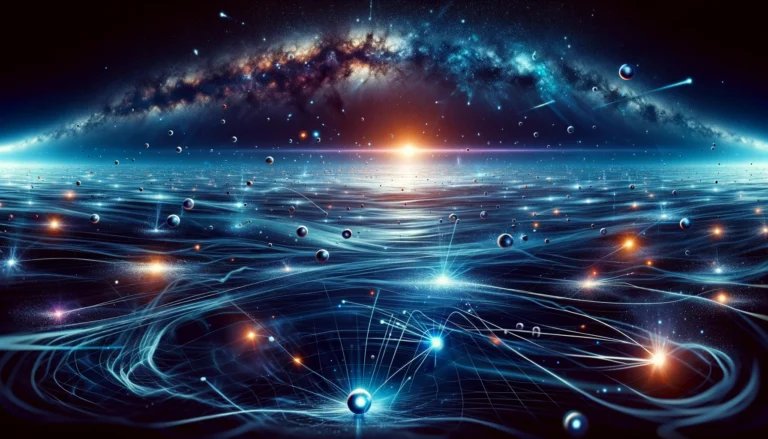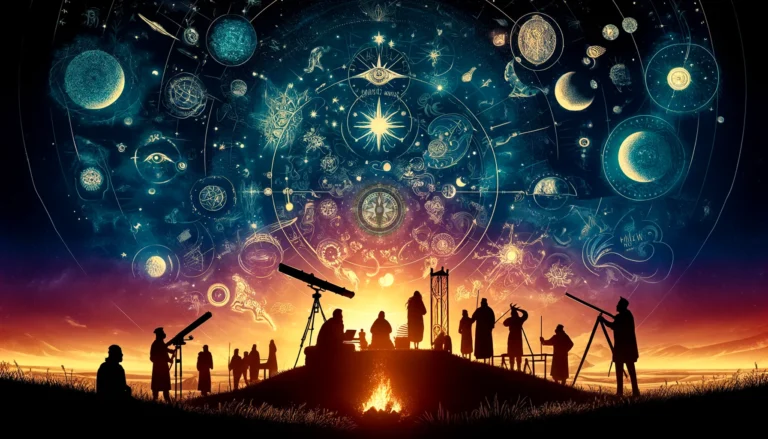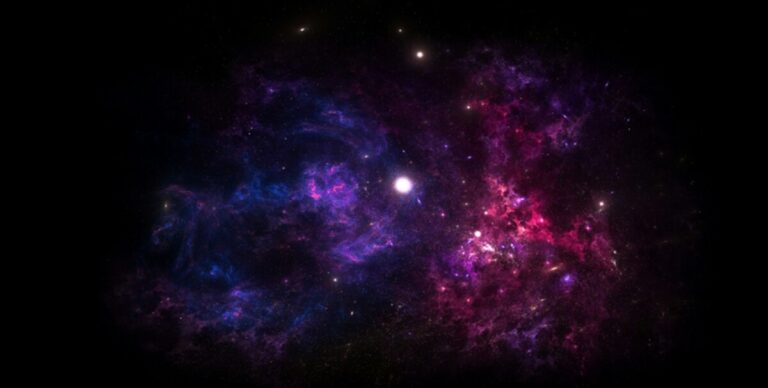Abstract: This article defines speculative ideas as either disproven or new concepts and places them within the context of the scientific method. It introduces the Idea Theory Framework, which outlines the path of all ideas from initial speculation through to scientific law. By examining the Rip-Bang theory and the evolutionary link between Gigantopithecus and Bigfoot, the article illustrates how speculative ideas transition from hypothesis to verified theories. This framework emphasizes the importance of distinguishing between speculative and empirical ideas to maintain the integrity of scientific exploration.
The Frontier of Knowledge: Where Speculative Ideas Meet Scientific Inquiry
Speculative ideas have always been a cornerstone of scientific exploration, pushing the boundaries of our understanding and inspiring new avenues of research. However, not all speculative ideas are created equal. Some, like the Rip-Bang theory, teeter on the edge of plausibility and fantasy, warranting a critical examination. These ideas often intersect with the philosophy of science, challenging us to distinguish between what is theoretically possible and what is empirically verifiable. In this article, we’ll delve into the nature of speculative ideas, their role in science, and how they transition from mere speculation to rational or disproven concepts.

First, lets position speculative ideas between science and spirituality. People want to understand the unknown, and they adopt beliefs about them, with or without evidence. In my work, spirituality is an open-minded exploration of reality based on science and reasoned thought, including understanding the nature of speculation. Being spiritual is a personal journey exploring concrete things, valid ideas of the mind, and the speculative. Speculative ideas attempt to describe the currently unknown or unknowable.
In my Idea of Ideas, I define all ideas as empirical, rational, or irrational. In “30 Philosophers” the irrational is defined this way:
Irrational Ideas are mental constructs that belong to a speculative framework, are logically inconsistent, or include non-falsifiable, unverified empirical elements or other irrational components.
The goal is to establish your beliefs within your worldview. Specifically, you define your personal language which helps you explore as well as set your personal religious views, both help you establish your personal philosophy to guide your life.
With that setting, let’s explore the speculative Rip-Bang theory. It’s a variation of the Big Rip and the Big Rip is a counter idea to the Big Freeze. All are variations based on the Lambda model of the universe. The Lambda model describes a universe that expands forever but does not overcome local gravity. This means our Local Group of 54 galaxies, which are gravitationally bound, will ride the expansion for nearly forever, but will eventually end in a Big Freeze.
The even more speculative Big Rip says the expansion wave will overcome gravity, eventually ripping everything apart including the strong force at the center of atoms. In this idea, the universe ends up filled with a diffuse cloud of particles expanding from each other, forever. This too eventually ends in a Big Freeze.
This Rip-Bang idea attempts to link the Big Rip idea to a new Big Bang. Somehow, as it rips apart the last particles, a new singularity sometimes occurs, causing a new universe. While it’s an interesting idea, it’s just a thought. Not disproven, just lacking empirical evidence and logical consistency. It’s an irrational idea based in the depths of other speculative and irrational ideas. To frame it, remember that all ideas start out as false and must prove themselves. All irrational ideas are irrationally false in a logical setting, whether disproven or newly proposed.

Absurd ideas are a dime a dozen. To illustrate this, consider another speculative idea: I have the idea that Bigfoot-like creatures are actually the descendants of Gigantopithecus. I’m mostly joking, but it was a thought I explored for a few minutes one day. And, here’s the thing, I do think it is more likely than the Rip-Bang. Yes, you can rank the speculative, and yes, it is more likely! I have lots of empirical data and I can actually map a very possible evolutionary path from them to sightings in North America. We know they survived in Asia until about 100,000 years ago. Is it all that unrealistic to explore the idea that a population diverged, migrated north, and crossed the Bering Strait? Fast forward, perhaps due to their elusive nature and dwindling numbers, they faded from the historical record, only to be glimpsed as Bigfoot in the modern era. This is all more likely than the so-called Rip-Bang theory, which doesn’t even attempt to explain how a final particle being ripped apart “sometimes” bursts into a new singularity.

Wild ideas are mostly scorned. For example, when a Catholic talks about the Holy Ghost as a literal being, non-believers quickly shoot it down. When Christians talk about the magical-supernatural Devil manifesting into various forms, scientists ask “How?” They refuse to explore further until the mechanisms are explained. When Mormons talk about Kolob, the planet of male spirits, feminists openly laugh at their absurd belief in planets dedicated to the male spirit.
Don’t get me wrong, I love any new idea, including wild ones. They are an important and natural part of inspiring new thinking. However, it’s crucial to clearly label them as what they are: speculation. When exploring irrational ideas, if you don’t separate the irrational from the rational, you end up confusing people. Many do this sort of thing under the guise of “blowing their mind,” but what they are really doing is just repeating a story—a fictional story often based less on empirical evidence than most romance novels. It’s important to carve out the speculative and focus on our rational ideas about the empirical.
Speculative ideas are a fundamental part of scientific exploration. All ideas start as speculative; they are hypotheses that scientists propose to explain phenomena or explore new concepts. These ideas are initially not disproven but remain speculative until evidence supports or refutes them.
In a logical setting, speculative ideas without empirical evidence are considered irrationally false. This doesn’t mean they are disproven; rather, they lack the evidence and logical consistency to be considered rational. As long as an idea remains speculative and unsupported by evidence, it stays in this category. Even new speculative ideas are irrationally false in a logical sense until proven otherwise.

Weekly Wisdom Builder
Got 4 minutes a week?
A new 4-minute thought-provoking session lands here every Sunday at 3PM, emailed on Mondays, and shared throughout the week.
Exactly what the world needs RIGHT NOW!
For instance, the Rip-Bang theory is not disproven, but it remains speculative and irrational without evidence. Similarly, if my idea about Bigfoot descendants were to be considered in a scientific context, it would need substantial evidence and logical consistency to move beyond speculation. What conspiracy theorists, conmen, do on the internet is take an idea like this, frame the speculation within known facts using an authoritative presentation to convince those not currently thinking with a critical mindset. However, if you understand the nature of ideas well, as framed in the Idea of Ideas as empirical, rational, and irrational, you will never be fooled again.
Also, and to be clear, once a speculative idea is disproven by empirical observation or logical inconsistency, it becomes a disproven speculative idea. It remains irrationally false, but with the added certainty that it has been shown to be incorrect. For example, if evidence were to definitively disprove the Rip-Bang theory, it would transition from speculative and irrational to disproven and irrational.
This distinction is crucial because it underscores the importance of evidence and logic in the scientific process. Speculative ideas can inspire new research and thinking, but they must be critically evaluated and tested. Without this scrutiny, they remain in the realm of irrational speculation.
Ranking Ideas: The Idea Theory Framework
Speculative ideas are a fundamental part of scientific exploration. All ideas start as speculative; they are hypotheses that scientists propose to explain phenomena or explore new concepts. These ideas are initially not disproven but remain speculative until evidence supports or refutes them.
Level 1: Ideas New, untested, untestable, and disproven ideas are speculative or disproven.
-
Speculative Idea: All ideas start out as speculative whether empirical, rational, or irrational. These are the questions or observations about the universe that have yet to be formulated into a precise, testable hypothesis. This includes intriguing or insightful ideas that are not yet falsifiable, like time travel and string theory.
-
Disproven Idea: These ideas failed empirical testing or are logically inconsistent and hence are irrationally false. Disproved ideas might contain good elements, but those good ideas need to be reformulated into a new theory.
Level 2: Hypothesis In this framework, the hypothesis step is a temporary step for testing the bundle of ideas.
- Hypothesis: At this stage, the idea has been precisely formulated into a testable hypothesis, or a series of tests, and a clear method of repeatable testing has been identified. It is falsifiable and scientific in nature but is still an irrational entity pending results.
Level 3: Theory Verified ideas are theories and are empirically true.
-
Superseded Theory: This applies to any empirically true idea that has been replaced with a better idea, a better theory. These ideas remain empirically true but have a more limited specific scope or set of conditions than other theories.
-
Verified Theory: The idea passed testing and is empirically true until disproven. These theories serve both to describe “what” happens under certain conditions and can include formulas. They also explain “how” and “why” phenomena occur.
-
Established Theory: These are verified theories with universal or near-universal applicability that have withstood extensive scrutiny and exhibit no significant unresolved questions or inconsistencies.
-
Law: Scientific laws are the fundamental mathematical formulations and their associated logically true statements extracted from established theories. These laws detail “what” happens under certain conditions, showcasing consistent and universal relationships.
For instance, the Rip-Bang theory is not disproven, but it remains speculative and irrational without evidence. Similarly, if my idea about Bigfoot descendants were to be considered in a scientific context, it would need substantial evidence and logical consistency to move beyond speculation.

Whether an idea is religious or scientific, both sides need to understand it is speculation. By more clearly stating what we know is true and what is speculative, they will more clearly communicate their ideas and garner support. They will also create better thinking humans. With true clarity comes true wisdom. Scientific researchers and communicators need to be precise about what we know, what we think is likely true, and what is pure speculation. And we all need to hold everyone to this standard, including religions that explore the known and unknown. Within the unknown, they are exploring the currently unknown, the stuff we hope to learn about, as well as the unknowable, the stuff we have no hope of ever understanding. Our exploration, our wisdom, will increase exponentially with better understanding and exploration of where the lines are drawn between the known, unknown, and unknowable.
— map / TST —
Discover the journey of human thought…
To fully understand the nature of ideas, nothing can replace reading the full story of human thought. My latest book, my 15th, introduces the Idea of Ideas in its most complete form and intricately explores how our ideas fit within the context of human thought. It tells the story of our ideas from 2600 BCE to today, all from our modern viewpoint and understanding. With a modern perspective, it weaves together history, science, and philosophy to illuminate the intricate web of human thought. Embark on this journey and witness the remarkable evolution of our ideas through the ages.
Coming December 2024: Immerse yourself in knowledge, not snippets.
- Discover how 30 influential philosophers shaped our understanding of the world.
- Explore the concepts that continue to influence science, art, and culture today.
- Get your copy now and start thinking like the greatest minds in history!

















